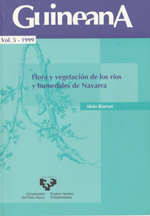Flora and vegetation of rivers and wetlands in Navarra
##plugins.themes.bootstrap3.article.main##
##plugins.themes.bootstrap3.article.sidebar##
Abstract
We have studied the edaphohygrophilous and edaphohalophilous vegetation in rivers, wetlands and salt marshes in Navarra. The studied territory comprises two hydrographyc basins: the Cantabrian Basin, with Bidasoa as main river, and the Mediterranean Basin, the main river of which, Ebro river, has in Navarra sorne of its bigger tributaries: Ega, Arga and Aragón. A great diversity of humid biotopes can be seen in this broad territory, from bogs and fens in the north to salt marshes in the Bardenas area. This habitat diversity is created by the changing lithology and climatology. Two macrobioclimates are recognized: temperate and mediterranean, and within them the following thermotypes: mesotemperate, supratemperate, orotemperate and criorotemperate for the temperate one, and mesomediterranean and supramediterranean for the mediterranean one. Conceming ombrotypes, semiarid, dry, subhumid, humid and hyperhumid (ultrahyperhumid included) appear.
This climatic and lithologic diversity is reflected in Biogeography. Two Regions are represented in Navarra: Eurosiberian and Mediterranean. Next sectors are recognized within them: Cántabro-Euskaldun, Westem Pyrenean, Castellano-Cantábrico, Riojano, Somontano aragonés and Bardenas-Monegros.The Braun-Blanquet phytosociological method has been followed for plant communities' study. 143 community types has been distinguished, grouped into 28 phytosociological classes. The following sintaxa are first described:
Salicetum neotrichae Br.-Bl. & O. Bolos 1958 salicetosum lambertianae subass. nova
Loto pedunculati-Juncetum conglomerati M. Herrera & F. Prieto in T.E. Díaz& F. Prieto 1994 juncetosum acutiflori subass. nova
Senecioni aquatici-Juncetum acutijlori Br.-Bl. & Tüxen 1952 molinietosum caeruleae subass. nova
Prunello hyssopifoliae-Plantaginetum serpentinae F. Prieto, Loidi, M. Herrera & Bueno ass. nova
Mentho suaveolentis-Juncetum inflexi Rivas-Martínez in Sánchez-Mata 1989 lotetosum glabri subass. nova
Paspalo-Agrostietum semiverticillatae Br.-Bl. in Br.-Bl., Gajewski, Wraber & Walas 1936 rorippetosum sylvestris subass. nova
Junco compressi-Caricetum divisae ass. nova
Junco compressi-Caricetum divisae juncetosum gerardii subass. Nova
Xanthio-Polygonetum persicariae O. Bolos 1957 polygonetosum lapathifolii subass. Nova
Caro verticillati-Glycerietum fluitantis J.A. Malina 1996 hypericetosum elodis subass. Nova
Eupatorio cannabini-Caricetum elatae Biurrun, J.A. Malina & Loidi ass. Nova
Rorippo sylvestris-Cyperetum longi ass. nova
Related to landscape study, we have recognized the following riparian geosigmeta and microgeosigmeta:
- Mesotemperate riparian geosigmetum of Cántabro-Euskaldun sector.
- Supratemperate riparian geosigmetum of Cántabro-Euskaldun sector.
- Supratemperate riparian geosigmetum ofWestem Pyrenean sector.
- Mesomediterranean and low supramediterranean riparian geosigmetum of Castellano-Cantábrico sector (and Navarro-Alavés subsector in Pamplona Basin)
- Mesomediterranean riparian geosigmetum of Riojano and Somontano aragonés sectors.
- Mesomediterranean riparian geosigmetum of Bardenas-Monegros sector.
- Aragonian halo-hygrophilous geosigmetum of gullies and salt marshes.
- Bog microgeosigmetum ofCántabro-Euskaldun sector.
- Pond and lake microgeosigmetum of Cántabro-Euskaldun sector.
- Reservoir microgeosigmetum of Cántabro-Euskaldun sector.
- Mesomediterranean pond and swamp microgeosigmetum of Aragonian subprovince (and Navarro-Alavés sector in Pamplona Basin).
As a result ofthe floristic study we presenta plant-list with 1.051 taxa, most of them linked to rivers and wetlands. Both collected plants and bibliographic citations are included. The following taxa are first recognized in Navarra: Bupleurum gerardi All., Carex extensa Good., Corrigiola litoralis L., Epilobium palustre L., Psilurus incurvus (Gouan) Schinz & Thell., Sparganium emersum Rehmann and Spirodela polyrhiza (L.) Schleiden.

